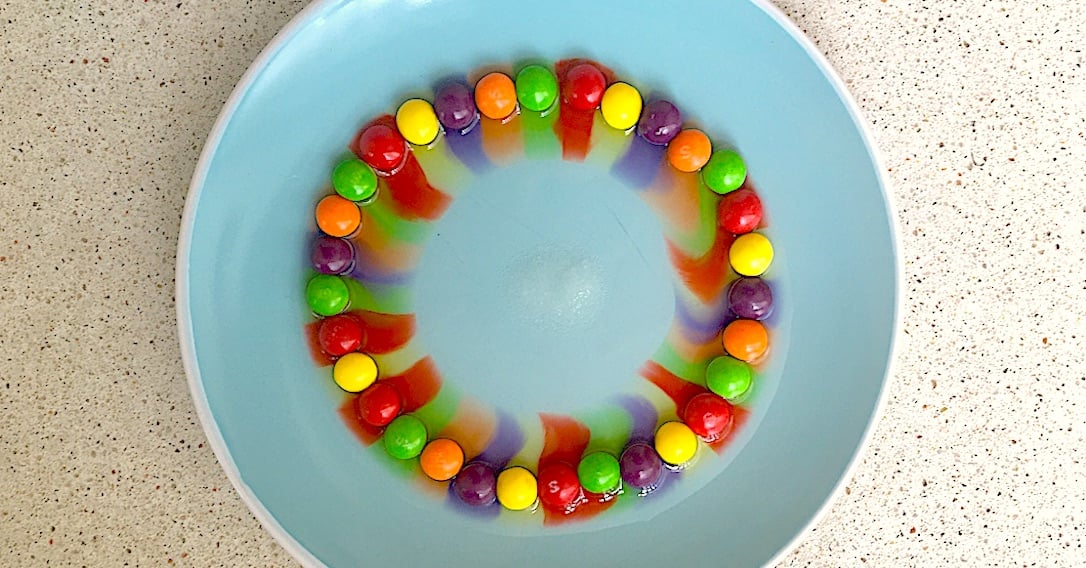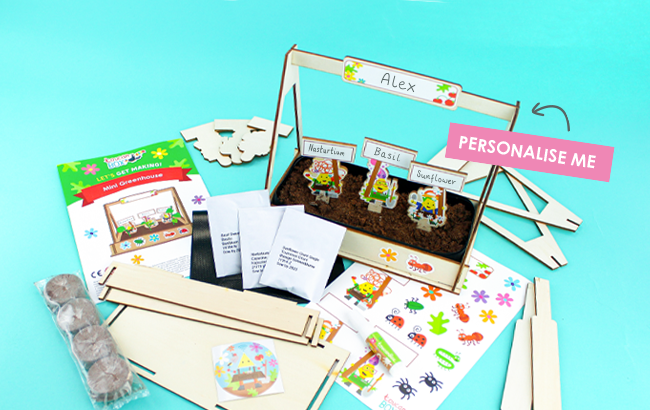Skittle Experiment
This super sweet Skittles experiment is the perfect way to teach kids about diffusion. Observe how Skittles make a mesmerising rainbow swirl when submerged in warm water. We recommend reserving a handful of Skittles to enjoy whilst watching the beautiful rainbow creep into the middle of the plate.
Make sure to scroll down to see our extra experiment suggestions! Discover how a teaspoon of sugar and different water temperatures can effect the speed and shape of the Skittles rainbow experiment. Changing the variables in an experiment is essential for learning and shows kids how results can vary when even the smallest factor is altered.
Happy experimenting!
Not what you’re after right now? You can subscribe to our newsletter to get weekly crafting inspiration sent to your inbox!
How do you do the Skittles rainbow experiment?
It’s super simple! Just grab these bits and bobs…
You Will Need
- A bag of skittles
- A plate
- Warm water
And follow these super simple instructions…
1 Arrange the Skittles in a circle on the outer curve of the plate.
2 Carefully pour warm water into the middle of the plate so that the sweets are half submerged.
3 Watch as the colour of the sweets slowly starts to creep towards the middle of the plate, making an amazing rainbow effect!
Pretty cool, right?! Now let’s get into the super sweet science behind the Skittles experiment…
Why do Skittles make a rainbow in water?
Skittles are made with colourful dyes and sugar. The warm water dissolves this dye and sugar and they move towards a place where there is less dye and sugar, in this case, the middle of the plate!
We call this process diffusion. Diffusion is the movement of particles (in this case, sugar) from a space of higher concentration (the outer curve of the plate) to a place of lower concentration (the middle of the plate).
Do you need hot water for the Skittles experiment?
We found that the Skittles rainbow experiment works best with warm water. Warm water makes the experiment slow enough to observe properly but not too slow for fidgety kids to lose interest!
Warm water dissolves the dye and sugar in the Skittles more quickly than cold or room temperature water does but not so quickly that the reaction is too quick to observe. Warm water is best for creating a steadily growing rainbow with well defined, separate colours. Once your child has observed the experiment with warm water you could test how different water temperatures effect the results…
Using very warm or boiling water creates a quicker but messier, murkier rainbow. Using room temperature water or cold water slows the process of the rainbow forming. The hotter the water the more quickly the rainbow will form, this is because the molecules in warm water move around more quickly than in cold water. So, when warm water molecules mix with the dye on the Skittles, they are quicker to “drag” that dye away and into the middle of the plate.
Try the rainbow Skittles experiment with different temperatures of water (make sure to always supervise children with warm or boiling water) to see how it changes the resulting look and speed of the rainbow.
How long does the Skittles experiment last?
If you use warm water then the rainbow Skittles experiment will last for a couple of minutes, from pouring the water onto the plate to the rainbow meeting in the middle of the plate. The rainbow colours creep in nice and slowly, so you and your child will easily be able to observe the process of diffusion.
However, you can continue to observe the experiment after the rainbow has met in the middle. Over time the rainbow colours will begin to merge into one another and make a rather murky colour! It’s not as pretty as it started out but it’s an interesting learning prompt, why do the colours start out separate and then blend together?
Why do the colours not mix in the Skittles experiment?
The colours don’t mix in the Skittles experiment because the concentration of sugar in each skittle is about the same. We know that diffusion is the movement from an area of high concentration to an area of low concentration. Because the Skittles have the same concentration of sugar they do not mix, they’re far too busy getting to the middle of the plate, the area with a low concentration of sugar.
Any good scientist knows that repeating an experiment is vital to ensuring reliable results! They also know it’s very important to test and try different variables to see how the results change…
Let’s try a different way…
You Will Need
- A bag of skittles
- A plate
- Warm water
- A tablespoon of sugar
1 Arrange the sweets in a circle on the outer curve of the plate.
2 Put a tablespoon of sugar in the middle of the plate.
3 Carefully pour warm water into the middle of the plate (but not directly onto the sugar) so that the sweets are submerged. You will find that when the colour begins to spread it slows down a lot when it reaches the sugar in the middle.
We know that diffusion makes the sugar and dye move to a place where there is a low concentration sugar and dye. So, adding a spoonful of sugar in the middle of the plate means that the sugar and dye solution isn’t as quick to go there, that’s why the rainbow colours don’t move to the middle as quickly when there’s a spoonful of sugar there.
We hope you enjoy conducting this colourful experiment! If you’re in need of more activities to keep your little scientists busy, why not try a toucanBox?
Not tried toucanBox yet?
Each toucanBox is also personalised with your child’s name, so they will be so excited when something addressed to them personally comes through the letterbox!
Sign up today and save 50% on your first box!
Not ready to commit? Subscribe to our fun-filled weekly newsletter, jam packed with craft ideas, recipes, fun activities and more!
SHARE YOUR CREATIONS WITH US
We’d love to see your creations, so why not share them on Facebook, Instagram or Twitter with #toucanBox. Our favourite snaps could feature in the next issue of toucanBox Magazine!





